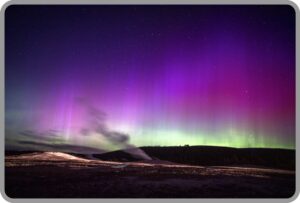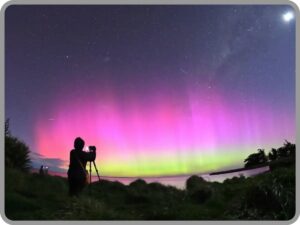Northern Lights Visible Across Northern U.S.: A Rare Celestial Spectacle You Can’t Miss
Are you ready for an unforgettable skywatching experience? The Northern Lights, also known as the Aurora Borealis, are once again making their way across the northern U.S., offering a breathtaking natural display that has captured the imagination of stargazers for centuries. From vibrant greens to radiant purples, this celestial phenomenon promises a visual feast for anyone fortunate enough to witness it.
In this blog post, we’ll explore when and where to see the Northern Lights, the science behind this mesmerizing event, and tips for capturing the perfect photo. Whether you’re an experienced skywatcher or a curious first-timer, here’s everything you need to know about the Northern Lights visible across the northern U.S.
What Are the Northern Lights?
The Northern Lights are a stunning natural light display that occurs when charged particles from the sun interact with Earth’s magnetic field. These particles collide with gases in Earth’s atmosphere, causing them to glow in various colors. The most common color is green, but you may also spot pink, purple, and red hues.
While the Aurora Borealis is most commonly seen in the polar regions, a strong solar flare can bring the Northern Lights much farther south—sometimes as far as the northern U.S.
When Are the Northern Lights Visible in the U.S.?
The best time to catch a glimpse of the Northern Lights is during winter months when nights are long and skies are darkest. However, the auroras can be visible from late fall to early spring, typically from September to March. The intensity of the lights can fluctuate depending on solar activity, so the best displays are usually seen during solar maximum years when the sun’s activity is at its peak.
For 2025, experts predict a significant uptick in Northern Lights visibility due to heightened solar activity, meaning the chances of spotting them across the northern U.S. are high!
Best Places to See the Northern Lights in the Northern U.S.
If you’re hoping to witness the magic of the Aurora Borealis, head to the northern states where the auroras are most visible. Some prime locations for catching the Northern Lights include:
-
Alaska: Fairbanks and Anchorage are known for offering some of the best viewing opportunities. With its long winter nights, Alaska is a hotspot for the Northern Lights.
-
Minnesota: Areas like the Boundary Waters Canoe Area and the Gunflint Trail offer dark skies perfect for skywatching.
-
Michigan: Head to Michigan’s Upper Peninsula for a chance to see the lights dance above Lake Superior.
-
North Dakota: Wide-open spaces and clear skies make North Dakota a great place to experience the Northern Lights.
-
Maine: For those in the northeastern U.S., Maine offers excellent chances of seeing this magical light show.
Tips for Viewing the Northern Lights
-
Check the Aurora Forecast: Websites and apps like NOAA’s Space Weather Prediction Center offer real-time Aurora forecasts to help you determine the best times for viewing.
-
Find Dark, Clear Skies: Light pollution can obscure the Northern Lights, so try to get away from city lights. Ideal locations include national parks, remote areas, and rural settings.
-
Be Patient: The Northern Lights can be elusive and sometimes take hours to appear. It’s worth the wait, though, as the display can last for several minutes to hours.
-
Dress Warmly: Winter nights in northern U.S. states can be bitterly cold, so make sure you dress in layers, bring warm beverages, and be prepared for long hours outdoors.
-
Bring a Camera: To capture the Northern Lights at their best, use a camera with manual settings. A tripod, wide-angle lens, and a slow shutter speed will give you the best shot.
The Science Behind the Northern Lights
The Northern Lights are a product of solar wind and Earth’s magnetic field. When charged particles from the sun (solar wind) collide with oxygen and nitrogen in Earth’s atmosphere, they release energy in the form of light. This phenomenon occurs near the magnetic poles, where Earth’s magnetic field lines converge.
Solar activity is cyclical, with an 11-year solar cycle. During solar maximum, the sun’s activity is at its highest, resulting in more frequent and intense aurora displays. This means that 2025 is expected to be a great year for the Northern Lights!
Why You Shouldn’t Miss This Event
Witnessing the Northern Lights is an experience unlike any other. The spectacle is not only visually stunning but also deeply humbling—a reminder of the incredible natural forces at play in our universe. Whether you’re a seasoned traveler or a first-time observer, the Northern Lights offer a chance to connect with nature in a truly awe-inspiring way.
With the 2025 solar activity reaching its peak, now is the time to start planning your Northern Lights adventure. Don’t miss out on the opportunity to experience one of nature’s most spectacular shows.
Final Thoughts
The Northern Lights visible across the northern U.S. are a once-in-a-lifetime opportunity to see one of the most awe-inspiring natural phenomena on Earth. From Alaska to Maine, there are plenty of locations offering prime viewing spots. Make sure to plan ahead, check the forecasts, and prepare for a night of stargazing you’ll never forget!
Have you ever seen the Northern Lights? Let us know about your experience in the comments below!


